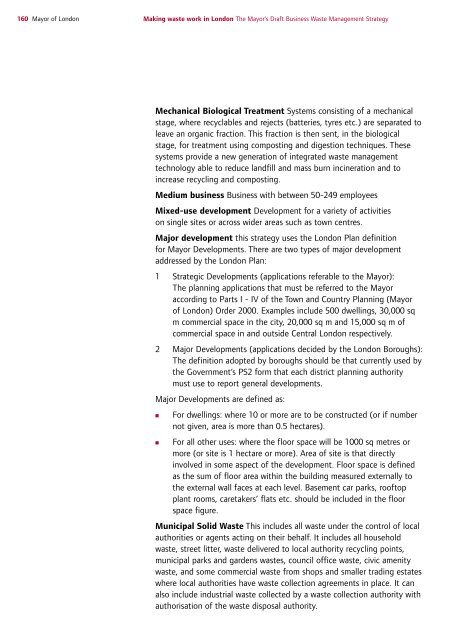Draft Business Waste Strategy PDF - london.gov.uk - Greater ...
Draft Business Waste Strategy PDF - london.gov.uk - Greater ...
Draft Business Waste Strategy PDF - london.gov.uk - Greater ...
You also want an ePaper? Increase the reach of your titles
YUMPU automatically turns print PDFs into web optimized ePapers that Google loves.
160 Mayor of London<br />
Making waste work in London The Mayor’s <strong>Draft</strong> <strong>Business</strong> <strong>Waste</strong> Management <strong>Strategy</strong><br />
Mechanical Biological Treatment Systems consisting of a mechanical<br />
stage, where recyclables and rejects (batteries, tyres etc.) are separated to<br />
leave an organic fraction. This fraction is then sent, in the biological<br />
stage, for treatment using composting and digestion techniques. These<br />
systems provide a new generation of integrated waste management<br />
technology able to reduce landfill and mass burn incineration and to<br />
increase recycling and composting.<br />
Medium business <strong>Business</strong> with between 50-249 employees<br />
Mixed-use development Development for a variety of activities<br />
on single sites or across wider areas such as town centres.<br />
Major development this strategy uses the London Plan definition<br />
for Mayor Developments. There are two types of major development<br />
addressed by the London Plan:<br />
1 Strategic Developments (applications referable to the Mayor):<br />
The planning applications that must be referred to the Mayor<br />
according to Parts I - IV of the Town and Country Planning (Mayor<br />
of London) Order 2000. Examples include 500 dwellings, 30,000 sq<br />
m commercial space in the city, 20,000 sq m and 15,000 sq m of<br />
commercial space in and outside Central London respectively.<br />
2 Major Developments (applications decided by the London Boroughs):<br />
The definition adopted by boroughs should be that currently used by<br />
the Government’s PS2 form that each district planning authority<br />
must use to report general developments.<br />
Major Developments are defined as:<br />
■ For dwellings: where 10 or more are to be constructed (or if number<br />
not given, area is more than 0.5 hectares).<br />
■ For all other uses: where the floor space will be 1000 sq metres or<br />
more (or site is 1 hectare or more). Area of site is that directly<br />
involved in some aspect of the development. Floor space is defined<br />
as the sum of floor area within the building measured externally to<br />
the external wall faces at each level. Basement car parks, rooftop<br />
plant rooms, caretakers’ flats etc. should be included in the floor<br />
space figure.<br />
Municipal Solid <strong>Waste</strong> This includes all waste under the control of local<br />
authorities or agents acting on their behalf. It includes all household<br />
waste, street litter, waste delivered to local authority recycling points,<br />
municipal parks and gardens wastes, council office waste, civic amenity<br />
waste, and some commercial waste from shops and smaller trading estates<br />
where local authorities have waste collection agreements in place. It can<br />
also include industrial waste collected by a waste collection authority with<br />
authorisation of the waste disposal authority.
















